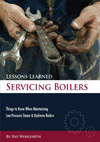Front-end loading is gaining momentum as a boiler system design strategy, as higher-efficiency condensing boilers replace older boiler technology and system control intelligence continues to improve. The idea of front-end loading is to marry condensing boilers to non-condensing boilers. This partnership makes sense because of the potential for an outdoor reset function to push the system temperatures from condensing to non-condensing during peak demand.
Typically, a condensing boiler will deliver thermal efficiencies in the high 90% range when the system return water temperatures are below 130°F (the dewpoint for natural gas boilers). When the warm, moist products of combustion fall below dewpoint, the moisture will cling to the heat transfer surfaces and release the latent heat.
Multiple Boiler Control and Outdoor Reset
Installing a condensing boiler and a non-condensing boiler together on the same system is an efficient use of the two technologies that works well and reduces the initial installed cost. Why isn’t it more common? There are necessary control functions to manage this that have only recently become commonly available. The control device must be programmed to choose the condensing boilers first in all operations, holding the non-condensing boiler in reserve. But equally important is outdoor reset. Outdoor reset will alter the system water temperature, moving it from condensing to non-condensing temperatures as the outdoor air temperature drops.
During most months in the boiler season, the system will operate with condensing inlet water temperatures below 130°F. But during the occasional high demand days, outdoor temperatures drop very low and the outdoor reset function drives the system temperature up to compensate. When this happens, system temperatures can rise above 130°F and pass out of condensing range. When that happens, the non-condensing boiler can be brought online.
The outdoor reset curve (Figure 2) shows a line for a 1:1 reset and another line for a 1:1.5 reset. In the 1:1 reset curve, the system water temperature will be increased 1°F for every 1°F drop in the outside temperature. In the 1:1.5 reset curve, the system water temperature will be increased 1.5°F for every 1°F drop in the outside temperature.
As you can see, both lines pass from condensing to non-condensing temperatures as the outdoor air temperature drops. These conditions are conducive to a front-end loaded system with one or two condensing boilers operating in a modular system with a non-condensing boiler as backup.
Low temperature conditions occur throughout the United States and can be particularly severe in the northern states. The temperature average graph (see Figure 3) provides an example of outdoor air temperature averages and extremes as seen at Chicago’s O’Hare International Airport.
A boiler system operating from September to March could see dramatic low temperature dips that could drive the outdoor air temperature below 0°F. As seen on the outdoor reset curve, temperatures below 0°F will drive the system water temperature into non-condensing temperature ranges, perfect for front-end loaded systems.
Low Water Temperature Protection
It is perfectly acceptable to fire the condensing boiler with non-condensing inlet water temperatures above 130°F. It is not acceptable to fire the non-condensing boiler with condensing inlet water temperatures below 130°F.
Non-condensing boilers are not designed to operate under condensing conditions and the effect will damage the boiler. Therefore, if a non-condensing boiler is scheduled to be installed with condensing boilers in a front-end loading system, low water temperature protection must be put in place to prevent the non-condensing boiler from receiving condensing inlet water temperatures.
This may be done with the control strategy. The control may be programmed to fire the non-condensing boiler only when non-condensing water temperatures are in the system. This idea has a downside. If the boiler system needs the extra fire power of the non-condensing boiler when condensing temperatures are required, then the control strategy will not allow the non-condensing boilers to fire. The system might go cold.
A better design is to utilize low water temperature protection on the non-condensing boiler that will allow it to operate in condensing conditions. This is achieved by adding manual bypass loops, motorized mixing valves, or automatic thermostatic mixing valves to the water piping of the non-condensing boilers. This will allow heated water from the outlet of the boiler to be mixed with the cool inlet water to maintain a requisite inlet water temperature at the boiler above 130°F.
Piping Strategies
Piping the condensing and non-condensing boilers together in a front-end loaded system can be tricky. Condensing and non-condensing boilers are different in design and may require different piping strategies. Check the equipment manufacturer’s recommendations first. Look for the strategy that works for all the boilers.
In all likelihood, primary/secondary piping will be the design that best serves all the boilers. Primary/secondary piping will combine all the equipment onto a manifold that branches off the main, system loop (see Figure 1). Each boiler would be fitted with a dedicated boiler pump to control flow through the boiler at the best possible flow rate. The manifolded boilers would work together as a team, sharing the same inlet water temperature and delivering a combined outlet water temperature to the system loop.
Front-end loading is a longstanding idea but has been used sparingly in the past few decades. However, more manufacturers are offering condensing and non-condensing boilers. More intelligent and low-cost electronic controls are available to provide the all-important control strategy. In fact, many boilers are being fitted with on-board control systems so smart they can provide front-end loading at no extra charge, making this a new frontier in boiler system design.









